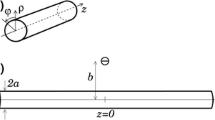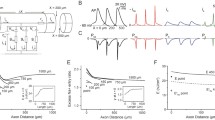Abstract
We studied uniform propagation on a central active fiber surrounded by inactive fibers in a multifibered bundle model lying in a large volume conductor. The behavior of a fully active bundle is considered in a companion paper. The bundle is formed by concentric layers of small cylindrical fibers (radius 5 μm), with a uniform minimum distance (d) between any two adjacent fibers, to yield a bundle radius of about 72μm. Individual vidual fibers are identical continuous cables of excitable membrane based on a modified Beeler-Reuter model. The intracellular volume fraction (f i) increases to a maximum of about 90% asd is reduced and remains unchanged ford<0.01 μm. In the range ofd<0.01 μm, the central fiber is effectively shielded from external effects by the first concentric layer of inactive fibers, and a large capacitive load current flows across the surrounding inactive membranes. In addition, the fiber proximity produces a circumferentially nonuniform, current density (proximity effect) that is equivalent to an increased average longitudinal interstitial resistance. The conduction velocity is reduced asd becomes smaller in the range ofd<0.1 μm, the interstitial potential becomes larger, and both the maximum rate of rise and time constant of the foot of the upstroke are increased. On the other hand, ford>0.1 μm, there are negligible changes in the shape of the upstroke, and the, behavior of the central fiber is close to that of a uniform cable in a restricted volume conductor. Ford larger than about 1.2 μm, the active fiber environment is close to an unbounded isotropic volume conductor.
Similar content being viewed by others
References
Beeler G. W., and H. Reuter. Reconstruction of the action potential of ventricular myocardial fibers.J. Physiol. (Lond.), 268:177–210, 1977.
Buchthal, F., and O. Steen-Knudsen. Impulse propagation in striated muscle fibers and the role of the internal current inactivation.Ann. N.Y. Acad. Sci. 81:422–445, 1959.
Cole, K. S., C. S. Li, and A. F. Bak. Experimental analogues for tissues.Exp. Neurol. 24:459–473, 1969.
Drouhard, J. P., and F. A. Roberge. Revised formulation of the Hodgkin-Huxley equations of the sodium current in cardiac cells.Comput. Biomed. Res. 20:333–350, 1987.
Henriquez, C. S., N. Trayanova, and R. Plonsey. Potential and current distributions in a cylindrical bundle of cardiac tissue.Biophys. J. 53:907–918.
Henriquez, C. S., and R. Plonsey. Simulation of propagation along a cylindrical bundle of cardiac tissues. I. Mathematical formulation.IEEE Trans. Biomed. Eng. 37: 850–860, 1990.
Henriquez, C. S., and R. Plonsey. Simulation of propagation along a cylindrical bundle of cardiac tissue. II. Results of simulation.IEEE Trans. Biomed. Eng. 37:861–875.
Hogues, H., L. J. Leon, and F. A. Roberge. A model study of electric field interactions between cardiac myocytes.IEEE Trans. Biomed. Eng. 39: 1232–1243, 1992.
Jack, J. J. B., D. Noble, and R. W. Tsien.Electric Current Flow in Excitable Cells Oxford, Clarendon Press, 1975, 502 pp.
Kleber, A. G., and C. B. Riegger. Electrical constants of arterially perfused rabbit papillary muscle.J. Physiol. (Lond.). 385:307–324, 1986.
Knisley, S. B., T. Maruyama, and J. W. Buchanan. Interstitial potential during propagation in bathed ventricular muscle.Biophys. J. 59:509–515, 1991.
Leon, L. J., and F. A. Roberge. A new cable model formulation based on Green's theorem.Ann. Biomed. Eng. 18:1–17, 1990.
Leon, L. J., and F. A. Roberge. A model study of extracellular stimulation of cardiac cells.IEEE Trans. Biomed. Eng. 40:1307–1319, 1993.
Luo, C.-H., and Y. Rudy. A dynamic model of the cardiac action potential. I. Simulations of ionic currents and concentration changes.Circ. Res. 74:1071–1096, 1994.
Milton, R. L., R. T. Mathias, and R. S. Eisenberg. Electrical properties of the myotendon region of frog twitch muscle fibers measured in the frequency domain.Biophys. J. 48:253–267, 1985.
Roberge, F. A., A. Vinet, and B. Victorri. Reconstruction of propagated electrical activity with a two-dimensional model of anisotropic heart muscle.Circ. Res. 58:461–475, 1986.
Rosenfalck, P.. Intra- and extracellular potential fields of active nerve and muscle fibersActa Physiol. Scand. Suppl. 321:1–168, 1969.
Roth, B. J.. Action potential propagation in a thick strand of cardiac muscle.Circ. Res. 68:162–173, 1991.
Sommer, J. R.. Implications of structure and geometry on cardiac electrical activity.Ann. Biomed. Eng. 11:149–157, 1983.
Sommer, J. R., and B. Scherer. Geometry of cell bundle appositions in cardiac muscle: Light microscopy.Am. J. Physiol. 248:H792-H803, 1985.
Spach, M. S., and R. C. Barr. Ventricular intramural and epicardial potential distribution during ventricular activation and repolarization in the intact dog.Circ. Res. 37:243–257, 1975.
Spach, M. S., and J. M. Kootsey. The nature of electrical propagation in cardiac muscle.Am. J. Physiol. 244:H3-H22, 1983.
Suenson, M.: Interaction between ventricular cells during the early part of excitation in the ferret heart.Acta Physiol. Scand. 125:81–90, 1985.
Taccardi, B., L. S. Green, P. R. Ershler, and R. L. Lux. Epicardial potential mapping: Effects of conducting media.Circulation 80:II-134 1989.
Trayanova, N., C. S. Henriquez, and R. Plonsey. Extracellular potentials, and currents of a single active fiber in a restricted volume conductor.Ann. Biomed. Eng. 18:219–238, 1990.
Vander Ark, C. R., and E. W. Reynolds, Jr. An experimental study of propagated electrical activity in the canine heart.Circ. Res. 26:451–460, 1970.
Vigmond, E. J., and B. L. Bardakjian. The effect of morphological interdigitation on field coupling between smooth muscle cells.IEEE Trans. Biomed. Eng. 42:162–171, 1995.
Wang, S., L.J. Leon, and F. A. Roberge. Interactions between adjacent fibers in a cardiac muscle bundle.Ann. Biomed. Eng. 24:662–674.
Author information
Authors and Affiliations
Rights and permissions
About this article
Cite this article
Roberge, F.A., Wang, S., Hogues, H. et al. Propagation on a central fiber surrounded by inactive fibers in a multifibered bundle model. Ann Biomed Eng 24, 647–661 (1996). https://doi.org/10.1007/BF02684178
Received:
Revised:
Accepted:
Issue Date:
DOI: https://doi.org/10.1007/BF02684178




